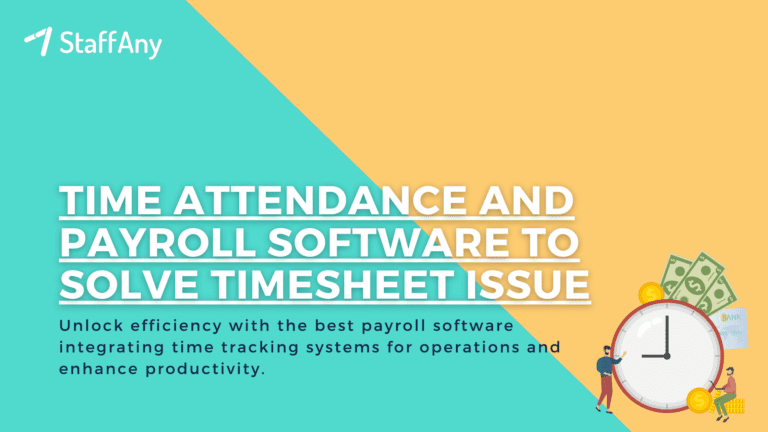In the dynamic realm of contemporary business, assessing and enhancing employee performance has become a pivotal practice for organisations seeking sustainable growth and success. At the heart of this practice lies the concept of staff performance evaluation. This integral process goes beyond measurement and delves into employee development and organisational improvement.
In this article, we will explore the depths of staff performance evaluation, unravelling its definition, significance, and multifaceted benefits. Let’s get started!
What is a Staff Performance Evaluation?

In essence, a staff performance evaluation is a structured and systematic approach through which an employee’s work-related achievements, competencies, and areas warranting growth are meticulously assessed.
This process transcends the realm of a mere performance measurement tool; it emerges as a potent vehicle for fostering personal and professional development.
As an employee journey through the trajectory of their role, the performance evaluation provides a comprehensive canvas onto which their contributions, challenges, and potential can be vividly depicted.
It is a mutual exploration undertaken by both the employee and the employer, one that seeks to understand the alignment between individual endeavours and the broader tapestry of organisational goals.
Navigating through the myriad dimensions of an employee’s performance, this evaluation encompasses diverse facets, including the quality of work delivered, adherence to established processes, communication skills, teamwork, leadership capabilities, and scope for innovation. Through this comprehensive analysis, the evaluation seeks to gauge past accomplishments and chart a roadmap for future growth.
Staff performance evaluation is a collaborative exercise that thrives on open communication, constructive feedback, and a shared commitment to excel.
In the fast-paced landscape of modern work, a staff performance evaluation stands as a reflective juncture where employees and employers converge to paint a picture of the past, sketch the contours of the present, and envision the landscape ahead.
Read more: Understanding Manpower Planning and Its Importance in F&B
Benefits of Staff Performance Evaluations
Performance evaluations are not merely administrative rituals; they are transformative catalysts that ripple across the fabric of an organisation, leaving a trail of advantages in their wake.
Here are some quintessential benefits of staff performance evaluations, illustrating why this practice is a cornerstone of progressive workforce management.
1. Personal and Professional Growth
Performance evaluations lay the foundation for a journey of growth that transcends the boundaries of a job description. As employees engage in introspection, they gain insights into their strengths and areas that beckon for enhancement.
Constructive feedback, delivered in the spirit of collaboration, acts as a mirror that reflects their accomplishments while pinpointing the avenues for refinement.
This process empowers individuals to set actionable goals, chart a course for advancement, and elevate their competencies, nurturing a sense of accomplishment and igniting a spirit of continuous self-improvement.
2. Enhanced Communication
Communication is the lifeblood of a harmonious work environment, and performance evaluations infuse fresh vitality into this vital conduit. These evaluations serve as structured forums where employees and managers engage in meaningful dialogues, transcending everyday interactions.
Employees can voice their aspirations, share challenges, and seek guidance, while managers can articulate expectations, offer insights, and applaud noteworthy contributions. This exchange nurtures a culture of transparency, strengthens relationships, and bridges the gaps that may hinder effective collaboration.
3. Goal Alignment
In the tapestry of organisational success, each thread contributes to the grand design. Performance evaluations unravel the intricate interplay between individual efforts and collective objectives.
By aligning employee goals with the overarching mission of the company, these evaluations transform individuals into stakeholders of the bigger picture. This newfound sense of purpose ignites a passion to contribute meaningfully, amplifying the harmony between personal ambitions and organisational aspirations.
4. Recognition and Rewards
Human beings thrive on recognition – the nourishment fuels motivation and drives performance. Performance evaluations provide a stage for acknowledging exceptional efforts that might go unnoticed.
This spotlight on achievements goes beyond verbal accolades; it materialises in tangible forms such as promotions, salary increments, and other incentives. By crystallising appreciation into rewards, these evaluations sow the seeds of job satisfaction and a sense of being valued, nurturing unwavering commitment.
5. Identifying Training Needs
Pursuing excellence is a continuous journey, often requiring skill upgrades and fresh competencies. Performance evaluations serve as the compass that guides employers in identifying these developmental needs.
By scrutinising performance data, managers can discern areas requiring enhancement and curate targeted training programmes. Investing in employee development enhances individual skill sets and reinforces the organisation’s capacity to adapt to evolving challenges.
Read more: 10 Best Training Plans for Restaurant Staff
What are the Criteria for Evaluating Employee Performance?
Evaluating staff performance is a crucial aspect of managing a team or organization. The specific criteria for employee performance reviews may vary depending on the nature of the work, industry, and organizational goals. However, some common criteria that are often used to measure employee performance including
1. Job Knowledge and Skills
Evaluating an employee’s performance begins with assessing their depth of understanding and proficiency in executing the tasks associated with their role. A comprehensive review includes an examination of their job-specific knowledge and the application of relevant skills. Consideration should also be given to any ongoing training or certifications that contribute to their professional development.
2. Quality of Work
The quality of an employee’s work is a fundamental criterion in performance evaluation. It involves scrutinizing the accuracy, precision, and thoroughness of their output. A high-performing employee consistently meets or exceeds established quality standards, ensuring that their work contributes positively to the overall goals and standards of the organization.
3. Productivity
Assessing an employee’s productivity involves measuring the quantity of work they complete within a specified timeframe. It encompasses their efficiency, time management skills, and ability to meet deadlines. A productive employee not only accomplishes tasks effectively but also manages their workload efficiently, ensuring optimal use of time and resources.
4. Initiative and Innovation
An employee’s initiative and innovation are key factors in evaluating their contributions to the organization. Proactive individuals take on new challenges willingly and contribute creative ideas or improvements. Recognizing and rewarding initiative encourages a culture of continuous improvement and forward-thinking within the team or organization.
5. Communication Skills
Effective communication is crucial in a professional setting. Evaluating an employee’s communication skills involves assessing their ability to convey information clearly, both in writing and verbally. It also includes active listening skills and the capacity to communicate effectively with team members, clients, and other stakeholders, fostering positive and collaborative relationships.
6. Teamwork and Collaboration
Teamwork and collaboration are essential for a harmonious work environment. Assessing an employee’s ability to work effectively with others involves evaluating their contributions to team projects and their willingness to assist colleagues. Interpersonal skills and the capacity to resolve conflicts positively contribute to a cohesive and high-performing team.
7. Adaptability
In today’s dynamic work environment, adaptability is a valuable trait. Evaluating an employee’s adaptability involves considering how well they handle change and navigate unexpected challenges. An adaptable employee demonstrates flexibility in adjusting to new tasks, technologies, or processes, contributing to the organization’s resilience in the face of change.
8. Leadership (if applicable)
For those in supervisory or managerial roles, leadership skills play a critical role in performance evaluation. Assessing leadership involves evaluating an individual’s ability to motivate, guide, and develop team members. Effective leadership contributes to a positive work culture and the achievement of organizational goals.
9. Attendance and Punctuality
A consistent and reliable attendance record is an important aspect of performance evaluation. Evaluating an employee’s attendance and punctuality reflects their commitment to the job and ensures that they contribute to a stable and predictable work environment.
10. Goal Achievement
Setting and achieving goals is a fundamental aspect of performance assessment. Evaluating an employee’s goal achievement involves assessing the extent to which they have met or exceeded performance targets, both at the individual and team levels. Recognizing and rewarding goal attainment reinforces a results-oriented culture.
11. Customer/Client Satisfaction (if applicable)
For roles involving direct interaction with customers or clients, their satisfaction is a crucial performance criterion. Evaluating feedback from external parties provides insights into how well an employee’s actions and contributions align with the expectations and needs of the organization’s customers, clients, or end-users. Positive customer satisfaction is indicative of effective performance in client-facing roles.
11 Fair Ways on How to Evaluate Staff Performance Effectively
Preparation is key to conducting an effective employee performance evaluation. Here are some tips to help you prepare:
1. Set Clear Objectives
Before conducting an employee performance evaluation, it’s important to have a clear understanding of the objectives of the evaluation. This will help you determine what performance metrics to assess and what you hope to achieve through the evaluation process.
2. Establish Performance Metrics
Determine which performance metrics are relevant to the employee’s role and aligned with the organisation’s objectives. These metrics can include productivity, quality of work, teamwork, customer service, and attendance, among others. Make sure the metrics are specific, measurable, and achievable.
3. Gather Relevant Information
Gather all relevant information that will help you evaluate the employee’s performance, including performance data, feedback from colleagues, and any relevant documentation. This information will be critical in determining the employee’s strengths, weaknesses, and areas for improvement.
4. Schedule a Meeting
Set up a meeting with the employee to discuss their performance evaluation. Make sure the meeting is scheduled at a time that is convenient for both parties and that there is enough time allocated for an in-depth discussion.
5. Be Objective
When conducting an employee performance evaluation, it’s important to be objective and fair. Focus on specific performance metrics and avoid personal biases. Be open and honest in your feedback, and provide specific examples to support your observations.
Read more: HR Management Softwares, Privilege or Necessity
6. Encourage Employee Feedback
Invite the employee to share their own feedback on their performance and to discuss any areas for improvement. Encourage a two-way conversation and be open to hearing their perspective. This will help to create a collaborative and positive atmosphere during the evaluation process.
7. Provide Regular Feedback
In addition to conducting a formal evaluation, it’s important to provide regular feedback to employees throughout the year. This helps employees understand their performance and areas for improvement in real-time, rather than waiting for a formal evaluation.
8. Set Actionable Goals
At the end of the evaluation, set actionable goals for the employee to work towards. These goals should be specific, measurable, and aligned with the employee’s role and the organisation’s objectives. Make sure to follow up with the employee regularly to track progress towards these goals.
9. Be Supportive
When conducting an employee performance evaluation, it’s important to be supportive and encourage employee growth and development. Provide constructive feedback and offer resources and support to help employees improve their performance.
10. Document the Evaluation
The next step is ensuring a document of employee performance evaluation. This documentation can include a written report or notes from the evaluation meeting. This documentation will serve as a record of the evaluation process and can be useful in future performance discussions and decision-making processes.
11. Performance Discussion and Planning
Finally, the crescendo of the performance evaluation process arrives in the form of a collaborative discussion. Employees and managers discuss the assessment results, sharing insights, concerns, and aspirations. This dialogue goes beyond a monologue of feedback; it is a two-way street where both parties contribute.
The conversation delves into achievements and challenges while setting the stage for future growth. This is where new goals are outlined, development plans crafted, and strategies defined. By concluding the process with a dialogue, the evaluation process transforms from a mere appraisal into a blueprint for advancement.
Read more: The Importance of Human Resource Planning in Business
Track Your Team’s Performance Review with HR reporting Software

Every step taken paves the way for growth, communication, and collaboration in the intricate dance of staff performance review. This process, fuelled by the pursuit of excellence, benefits employees and organisations, aligning individual aspirations with collective goals.
With StaffAny’s HR reporting software, you can access real-time information and export reports with just one click. By this mean, you can monitor your employee performance evaluations, your stores and stay up-to-date with real-time data collection by StaffAny’s management reporting tool.
Furthermore, in the realm of workforce management, refining processes is essential. To assist in this journey, consider leveraging the power of StaffAny’s employee shift scheduling software. Enhance your operational efficiency by gaining real-time visibility into labour costs during scheduling.
With our budgeting feature, you’ll effortlessly control expenses, optimising your manpower budget to drive profitability. Embrace the future of performance evaluation and workforce management by embracing StaffAny’s solutions!











